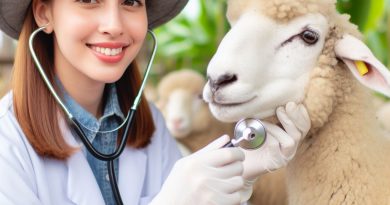Deer Farming: Managing Health & Disease
Last Updated on January 22, 2024
Introduction
Deer farming, cultivating deer for various purposes, is a dynamic venture requiring meticulous attention.
Importance of managing health and disease
- Economic Stability: Healthy deer contribute to a stable and profitable farming operation.
- Ethical Responsibility: Ensuring the well-being of deer aligns with ethical farming practices.
- Disease Prevention: Proactive measures prevent disease outbreaks, safeguarding the entire deer herd.
- Quality Products: Healthy deer yield superior products, enhancing the farm’s reputation and marketability.
In this section, we delve into the essence of deer farming, understanding its nuances, and emphasizing the critical role health management plays in sustaining a thriving deer farming enterprise.
Understanding the Health Risks in Deer Farming
A. Common diseases affecting deer
1. Chronic Wasting Disease (CWD)
Chronic Wasting Disease (CWD) is a fatal neurodegenerative disease that primarily affects deer species.
It belongs to the transmissible spongiform encephalopathies (TSE) group, characterized by the accumulation of an abnormal form of cellular protein called prions.
Once infected, deer experience progressive weight loss, behavioral changes, and neurological issues.
I. Transmission and prevalence
The transmission of CWD occurs through direct contact with contaminated body fluids and tissues, or through indirect contact with contaminated environments, such as soil and vegetation.
It is highly contagious, and the prevalence has been increasing in deer populations across North America, including wild and farmed deer.
II. Impact on deer populations and farming industry
CWD poses a significant threat to the deer farming industry.
Infected animals shed prions in the environment, increasing the risk of transmission to healthy deer.
This has negative implications for deer populations, as it can cause significant reduction in numbers and genetic diversity.
Additionally, it poses economic losses for deer farmers, as CWD-infected deer cannot be traded or sold, limiting their market opportunities.
2. EHD and Bluetongue
Epizootic Hemorrhagic Disease (EHD) and Bluetongue are viral diseases transmitted by biting midges and, occasionally, mosquitoes.
They primarily affect wild and farmed deer, causing fever, excessive salivation, ulcers in the mouth, and hemorrhages throughout the body.
I. Spread and control measures
These diseases are spread through the biting insects, which act as vectors.
They prefer warm and humid environments, increasing the transmission risk during favorable weather conditions.
Control measures involve insect control, such as reducing breeding sites and using insecticides, to minimize vector populations.
Vaccination programs can also be implemented to mitigate disease spread.
II. Economic implications
The economic implications of EHD and Bluetongue are significant.
Infected deer often exhibit reduced appetite and weight loss, affecting their overall growth and market value.
Furthermore, the cost of implementing control measures and veterinary care can be substantial for deer farmers, impacting their profitability.
3. Other diseases
Apart from CWD, EHD, and Bluetongue, deer farming also faces the risk of other diseases.
Bovine Tuberculosis (bTB) can be transmitted from cattle to deer, causing respiratory issues and weight loss.
Hemorrhagic Disease (HD) is another viral disease that affects deer, causing extensive internal bleeding and high mortality rates.
Furthermore, parasites and ticks can infest deer, leading to skin lesions, anemia, and reduced productivity.
Preventing these diseases requires implementing biosecurity measures, such as maintaining a closed herd, regular veterinary check-ups, and vaccination programs.
Regular inspections for parasites and ticks are also essential to minimize their impact on deer health and productivity.
Therefore, understanding the health risks in deer farming is crucial for effective management and disease prevention.
Chronic Wasting Disease, EHD, Bluetongue, and other diseases pose significant challenges to the deer farming industry.
Implementing appropriate control measures and biosecurity practices can help mitigate these risks and ensure the health and well-being of farmed deer populations.
Read: Innovative Poultry Housing Solutions in 2024
Prevention and Management Strategies
Proper management of deer health and disease prevention is essential for successful deer farming.
Implementing the following strategies will help ensure the well-being and longevity of the deer population on the farm.
A. Ensuring Proper Nutrition
Providing quality deer feed is of utmost importance.
Deer require a balanced diet to meet their nutritional needs and maintain a strong immune system.
Feeding them a diet rich in essential nutrients and good quality forage helps promote overall health and reduces the risk of diseases.
In addition to quality deer feed, supplementing their diet with vitamins and minerals can further strengthen their immune system.
Deer farming involves managing a high-density population, making them more susceptible to nutrient deficiencies.
Providing them with necessary supplements can help prevent these deficiencies and boost their immune response.
B. Vaccination Programs
Regular vaccinations are essential for preventing the spread of infectious diseases among deer populations.
Vaccines help build immunity against specific diseases and significantly reduce the risk of outbreaks.
Implementing a proper vaccination program is crucial for maintaining the health and productivity of the deer herd.
It is important to consult with a veterinarian to determine the recommended vaccines for deer farming.
Common vaccinations for deer include those against diseases like Chronic Wasting Disease (CWD), bovine tuberculosis, and various respiratory and gastrointestinal infections.
Administering these vaccines at the appropriate time and following the recommended schedule is vital for achieving maximum efficacy.
C. Biosecurity Measures
Implementing strict biosecurity measures is essential for preventing the introduction and spread of diseases on deer farms.
Controlling access and movement of animals can help reduce the risk of disease transmission.
Fencing and implementing restricted entry protocols can prevent contact with wild deer and other potentially infected animals.
Quarantine protocols should be established for any new animals introduced to the farm.
Isolating and monitoring newly acquired or sick animals for a period of time helps identify any potential diseases before introducing them to the main deer population.
This measure minimizes the risk of introducing pathogens and ensures the overall health of the herd.
D. Regular Health Monitoring
Regular health monitoring is critical in identifying potential health issues in deer populations.
Conducting routine health check-ups and physical examinations allows for early detection of diseases, facilitating prompt response and appropriate treatment if necessary.
Early disease detection helps prevent the spread of infectious diseases within the herd.
Monitoring the health of individual animals and observing any changes in behavior, appetite, or physical appearance can help identify potential cases.
Maintaining accurate records of health observations and implementing surveillance programs can aid in tracking disease patterns and implementing effective disease management strategies.
Most importantly, effective management of deer health and disease prevention involves ensuring proper nutrition, implementing vaccination programs, practicing biosecurity measures, and conducting regular health monitoring.
By prioritizing these strategies, deer farmers can minimize the risk of disease outbreaks and maintain a healthy and productive deer population.
Read: Optimal Nutrition for Chickens & Turkeys

Maintaining Clean and Safe Farming Environments
When it comes to managing health and disease in deer farming, maintaining clean and safe environments is of utmost importance.
By implementing effective waste management strategies and ensuring secure fencing and appropriate facility design, farmers can minimize the risk of diseases and maintain the well-being of their deer population.
A. Effective waste management
1. Proper disposal of carcasses and waste materials
To prevent disease outbreaks and minimize potential contamination, it is vital to have a proper waste disposal system in place.
Farmers should promptly remove and dispose of any carcasses, as well as any waste materials that may accumulate within the farm.
This includes ensuring the appropriate burial or incineration of carcasses, as well as the proper storage and disposal of other waste materials.
2. Reducing disease transmission through feces and urine
Deer can shed pathogens through feces and urine, leading to disease transmission within the herd.
To minimize this risk, farmers should regularly clean and remove manure from deer pens and enclosures, using appropriate disinfectants.
It is also crucial to ensure proper drainage and hygiene practices to reduce the potential for disease spread through contaminated fecal matter or urine.
B. Secure fencing and facility design
1. Preventing outside wildlife contact
Deer can be vulnerable to diseases transmitted by other wildlife species.
To prevent such contact and minimize the risk of disease introduction, proper fencing is necessary.
Fences should be secure and designed to prevent entry by other wildlife, such as wild deer or infected animals.
Regular inspections and maintenance of fences are essential to ensure their effectiveness in keeping outside wildlife away.
2. Appropriate facilities for isolation and treatment
In case of disease outbreaks or the need for individual deer treatment, proper isolation facilities are essential.
These facilities should allow for the separation of sick or infected deer from the healthy population to prevent disease spread.
They should have adequate ventilation, drainage systems, and appropriate dimensions to provide a stress-free environment for treatment and recovery.
In essence, maintaining clean and safe farming environments is crucial for effective health and disease management in deer farming.
By implementing proper waste management practices and ensuring secure fencing and appropriate facility design, farmers can reduce the risk of disease transmission and maintain a healthy deer population.
Read: Beekeeping Health: Hive Disease Prevention
Collaboration with Veterinarians and Experts
A. Importance of veterinary involvement
One crucial aspect of managing the health and disease in deer farming is the collaboration with veterinarians and experts in the field.
Their involvement is of utmost importance in ensuring the overall well-being of the deer herd.
Veterinarians have the expertise and knowledge to diagnose and treat potential health issues that may arise in the deer population.
They possess the necessary training and skills to assess and manage diseases, ensuring proper care and prevention techniques are implemented.
By working closely with veterinarians, deer farmers can receive timely advice on vaccination protocols, disease prevention strategies, and management practices, which are vital for maintaining a healthy herd.
B. Partnerships and hiring specialized consultants
In addition to collaborating with veterinarians, deer farmers can also establish partnerships and hire specialized consultants to enhance their disease management efforts.
These consultants can provide valuable insights and expertise in specific areas of deer health and disease management, such as nutrition, genetics, or biosecurity measures.
These partnerships can help farmers identify potential health risks and develop appropriate strategies for disease prevention and control.
C. Regular consultation and advice
To ensure the ongoing health and well-being of the deer herd, it is important to have regular consultations with veterinarians and experts.
These consultations can help farmers stay updated on emerging diseases, new treatment methods, and best practices in disease management.
Regular communication with experts allows farmers to address any concerns or issues promptly, minimizing the risk of disease outbreaks and ensuring optimal herd health.
A collaborative approach between veterinarians, experts, and deer farmers is essential to effectively manage health and disease and maintain the long-term sustainability of deer farming operations.
Through constant communication and guidance from these professionals, farmers can implement proactive measures to prevent and control diseases, ultimately protecting the welfare of their deer population and their business.
In fact, collaboration with veterinarians and experts is crucial in managing health and disease in deer farming.
Their involvement provides essential knowledge and expertise, helping farmers implement effective preventive measures and promptly address potential health issues.
By establishing partnerships and seeking regular advice from these professionals, deer farmers can ensure the prosperity and longevity of their operations in the face of health challenges.
Read: Llama & Alpaca: Preventive Health Tips
Conclusion
Effectively managing health and disease in deer farming is pivotal for sustained success.
Recognizing the significance of this, key strategies have been highlighted.
Regular health assessments, balanced nutrition, proper shelter, and prompt isolation of sick individuals are imperative.
Employing a meticulous vaccination protocol further fortifies disease prevention. Continuous learning is a cornerstone for success.
Staying abreast of the latest research, participating in workshops, networking with peers, and promptly adapting best practices foster a dynamic approach to health management.
The vitality of a comprehensive health management plan cannot be overstated.
By integrating these strategies and fostering a commitment to ongoing learning, deer farmers can ensure the longevity and prosperity of their operations.


